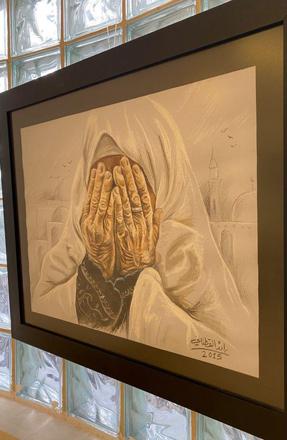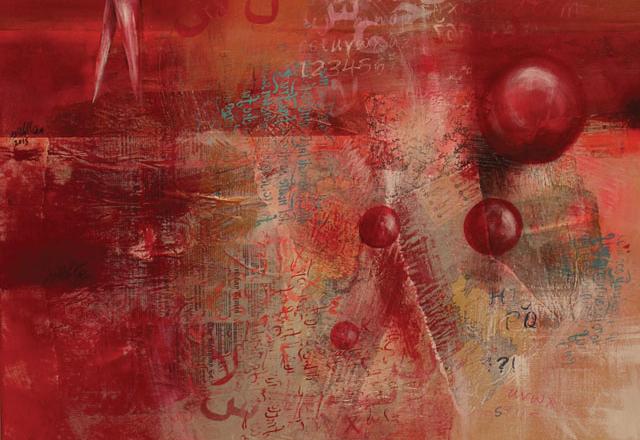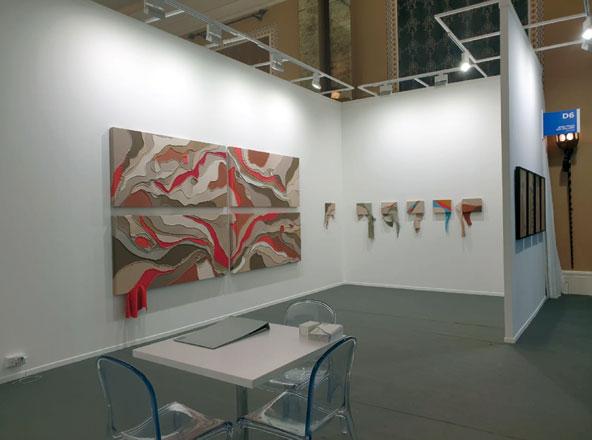You are here
Iraqi artist turns ‘ruins, rubble’ into works of art
By Mays Ibrahim Mustafa - Sep 15,2022 - Last updated at Sep 15,2022

An artwork on display by Iraqi artist Hanaa Malallah at the Jordan National Gallery of Fine Arts’ Building 2 (Photo by Mays Ibrahim Mustafa)
AMMAN — Artist Hanaa Malallah is turning Iraq’s debris into artistic creations, reflecting her experience of war and fascination with archaeology.
Under the patronage of HRH Princess Wijdan Al Hashemi, her exhibition, titled “Ruins & Rubble”, opened at the Jordan National Gallery of Fine Arts’ Building 2 on Wednesday.
Through her work, the artist addresses the difference between two types of physical remains in Iraq.
“While archeological ruins are indicative of a past civilisation with deep connections to our present and future, rubble is the result of human destruction, violence and war, indicating a loss of culture and identity,” she told The Jordan Times.
Some of her works presented in the exhibition explore the “pictorial depictions” of the Warka Vase, an artifact of Mesopotamia.
Malallah noted her “fascination” with the carved vessel began when she first saw it at the Archaeological Museum of Baghdad in the ‘70s.
“Such fascination has been centred on its composition and how its relief layers eloquently depict a pictorial record that spells out the drama of life and the cycle of fertility, so much so that its cavity contained the store of seeds for planting,” she said.
Born in Iraq in 1958, Malallah, who currently resides in London, has lived through the political instability of her home country and has experienced the hardships of war.
Through one of her art projects currently on display, she commemorates the victims of the Amiriyah shelter bombing in 1991, which took the lives of 408 civilians. When Malallah visited the shelter a few months following the tragedy, she saw photographs of the victims hung up by their families.
“The images etched themselves deeply into my heart, and a strong desire to memorialise the dead of Al Amiriyah took up residence in my soul,” the artist said.
A small booklet was later published listing the victims’ names, but only 100 of them were accompanied by photographs, according to Malallah.
Roughly 30 years following her visit, she created bas-relief portraits of the victims layered with “burnt or singed calico and thin cotton material with the texture of bandages” through a practice she termed the “Ruins Technique”, “where the creative process begins with an act of destruction”.
The victims without portraits are commemorated on highly polished brass plates with reflective surfaces, on which an Arabic sentence is engraved, reading either “She has no image” or “He has no image”, or writing their names in Abjad numerals.
“The role of the human face is paramount in the social and mutually responsible encounter with the other. It is the locus of personhood and is capable of expressing meaning before a single word is spoken,”the Iraqi artist noted.
Moreover, Malallah described herself as a conceptual artist, who aspires for her art to carry a message which “transcends the used material”.
The exhibition, which lasts until October 5, displays around 50 artworks which involve the use of various techniques, such as triptych and digital printing, along with an array of mediums, including canvas, brass, video and ceramic.
Related Articles
AMMAN — A group art exhibition, titled “Her”, seeking to discover an incredible diversity of women faces, opened on Tuesday at the Foresight
When talented and creative Arab women come together to showcase their artwork, the outcome encompasses an abundance of exquisite expression, craftsmanship and ingenuity.
AMMAN — Wadi Finan Art Gallery has recently announced its participation at the Art Dubai Exhibition, which will end on Saturday. Accord



















